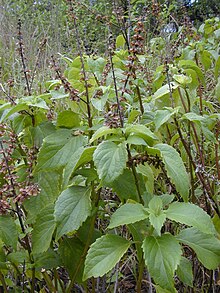| African basil | |
|---|---|

| |
| Scientific classification | |
| Kingdom: | Plantae |
| Clade: | Tracheophytes |
| Clade: | Angiosperms |
| Clade: | Eudicots |
| Clade: | Asterids |
| Order: | Lamiales |
| Family: | Lamiaceae |
| Genus: | Ocimum |
| Species: | O. gratissimum
|
| Binomial name | |
| Ocimum gratissimum | |
Ocimum gratissimum, also known as clove basil, African basil,[1] and in Hawaii as wild basil,[2] is a species of basil. It is native to Africa, Madagascar, southern Asia, and the Bismarck Archipelago, and naturalized in Polynesia, Hawaii, Mexico, Panama, West Indies, Brazil, and Bolivia.[3]
Other names[edit]
O. gratissimum is a common culinary herb in West Africa and is used by some in the Caribbean, going by many local names, even in the Indian subcontinent.
- Ebe-amwonkho in Edo
- Tchayo in Fon
- Dogosui in Ewe
- Efirin in Yoruba[4]
- Tamwṍtswã́gi in Nupe
- Ajuntita in Ikwerre
- Nchanwu in Igbo[4]
- Kpan-sroh in (Irigwe language)
- Añyeba in Igala
- Daidoya in Hausa[4]
- Nchuanwu also Arimu in Igbo
- Ntong in Ibibio, Efik
- Kunudiri in Kirikeni Okuein
- Nunum in Akan
- Nunu Bush in Jamaica (from the Akan language)
- Yerba di holé in Papiamento
- Fobazen in Haiti
- Scent leaves in Nigeria (the standardised Nigerian English rendering) and in the African diaspora
- Mujaaja in Uganda
- Vaayinta (వాయింట) in Telugu
- Maduruthala in Sri Lanka මදුරුතලා
- Kattutulasi(കാട്ടുതുളസി), Kattu Thrithaav (കാട്ടു തൃത്താവ്) in Kerala
- Bai yeera in Thai ใบยี่หร่า
- Rehani in Georgian რეჰანი
- Van Tulsi (વન તુલસી) in Gujarati
- Tomka leaf (তোমকা/তোমহা পাতা) in chittagoneon Bangla
- Awromangnrin in Baoulé
- 'Kungurekwu u tamen in Tiv
- Nchuanwu in Igbo language
- ደማከሴ (Demakese) in Ethiopia[5]
Uses[edit]
In Nigeria, scent leave is used in making pepper soup, local rice, beans, plantain, even regular soup, and other delicacies.
Seed germination[edit]
Seeds seem to need strong sunlight to germinate, although germination has been achieved even during an average UK summer.[6]
Phytochemical compounds[edit]
The phytochemicals present in Ocimum gratissimum contains polyphenols such as Gallic acid, Rosmanol, rosmarinic acid, flavonoids such as Nepetrin, Quercetin, Rutin,
Catechin, and also alkaloids and terpenoids. Naringin, uteolin, Apigenin, Nepetoidin, Nevadensin, Hymenoxin, Salvigenin, Apigenin, 7,4,′-dimethyl ether, Basilimoside, 2alpha, 3 beta-Dihydroxyolean- 12en-28-oic acid, Methyl acetate, Oleanolic acid [7]
Pharmacology of extracts and essential oils[edit]
The essential oil of Ocimum gratissimum contains eugenol and shows some evidence of antibacterial activity.[8][9][10][11] The essential oil has potential for use as a food preservative,[12] and is toxic to Leishmania.[13]
Insect repellent[edit]
O. gratissimum repels the thrips Thrips tabaci, and so is a useful insect repellent in other crops.[14]
References[edit]
- ^ PLANTS Profile for Ocimum gratissimum | USDA Plants, Retrieved Jan. 7, 2009.
- ^ Ocimum gratissimum - Wild Basil (Lamiaceae). Hawaiian Ecosystems at Risk project (HEAR)
- ^ Kew World Checklist of Selected Plant Families
- ^ a b c Faluyi, Olufunke (2020). "The medicinal values of scent leaf (Ocimum gratissimum)". The Punch. Retrieved 2022-12-31.
- ^ "Plant list".
- ^ Influence of light, temperature and gibberellic acid on the germination of Ocimum gratissimum L. (Lamiaceae) seeds and evaluation of physiological quality by the X-ray test Martins J.R., Alvarenga A.A., Castro E.M., Batista L.A., Silva A.P.O. Revista Brasileira de Plantas Medicinais 2008 10:2 (44-49)
- ^ Islam, Md. Torequl; de Alencar, Marcus Vinícius Oliveira Barros; da Conceição Machado, Katia; da Conceição Machado, Keylla; de Carvalho Melo-Cavalcante, Ana Amélia; de Sousa, Damiao Pergentino; de Freitas, Rivelilson Mendes (2015). "Phytol in a pharma-medico-stance". Chemico-Biological Interactions. Elsevier BV. 240: 60–73. doi:10.1016/j.cbi.2015.07.010. ISSN 0009-2797. PMID 26296761. S2CID 29821324.Venuprasad, M.P.; Kumar Kandikattu, Hemanth; Razack, Sakina; Khanum, Farhath (May 2014). "Phytochemical analysis of Ocimum gratissimum by LC-ESI–MS/MS and its antioxidant and anxiolytic effects". South African Journal of Botany. 92: 151–158. doi:10.1016/j.sajb.2014.02.010.
- ^ Chemical composition, antibacterial activity in vitro and brine-shrimp toxicity of the essential oil from inflorescences of Ocimum gratissimum L., Lamiaceae Silva L.L., Heldwein C.G., Reetz L.G.B., Hörner R., Mallmann C.A., Heinzmann B.M. [In Process] Brazilian Journal of Pharmacognosy 2010 20:5 (700-705)
- ^ Celso Vataru Nakamura, Tania Ueda-Nakamura, Erika Bando, Abrahão Fernandes Negrão Melo, Díogenes Aparício Garcia Cortez, Benedito Prado Dias Filho, "Antibacterial Activity of Ocimum gratissimum L. Essential Oil", Memórias do Instituto Oswaldo Cruz, Vol. 94(5): 675-678.
- ^ Justification for the use of Ocimum gratissimum L in herbal medicine and its interaction with disc antibiotics Nweze E.I., Eze E.E. BMC Complementary and Alternative Medicine 2009 9 (37) Article Number 1472
- ^ Nutritional and antimicrobial properties of Ocimum gratissimum leaves Oboh F.O.J., Madsodje H.I., Enabulele S.A. Journal of Biological Sciences 2009 9:4 (377-380)
- ^ Food preservative potential of essential oils and fractions from Cymbopogon citratus, Ocimum gratissimum and Thymus vulgaris against mycotoxigenic fungi Nguefack J., Dongmo J.B.L., Dakole C.D., Leth V., Vismer H.F., Torp J., Guemdjom E.F.N., Mbeffo M., Tamgue O., Fotio D., Zollo P.H.A., Nkengfack A.E. International Journal of Food Microbiology 2009 131:2-3 (151-156)
- ^ Effects of essential oils from Cymbopogon citratus (DC) Stapf., Lippia sidoides Cham., and Ocimum gratissimum L. on growth and ultrastructure of Leishmania chagasi promastigotes Oliveira V.C.S., Moura D.M.S., Lopes J.A.D., De Andrade P.P., Da Silva N.H., Figueiredo R.C.B.Q. Parasitology Research 2009 104:5 (1053-1059)
- ^ Kirk, William D. J.; de Kogel, Willem Jan; Koschier, Elisabeth H.; Teulon, David A. J. (2021-01-07). "Semiochemicals for Thrips and Their Use in Pest Management". Annual Review of Entomology. Annual Reviews. 66 (1): 101–119. doi:10.1146/annurev-ento-022020-081531. ISSN 0066-4170. PMID 33417819. S2CID 231304158.
External links[edit]
- Dressler, S.; Schmidt, M. & Zizka, G. (2014). "Ocimum gratissimum". African plants – a Photo Guide. Frankfurt/Main: Forschungsinstitut Senckenberg.